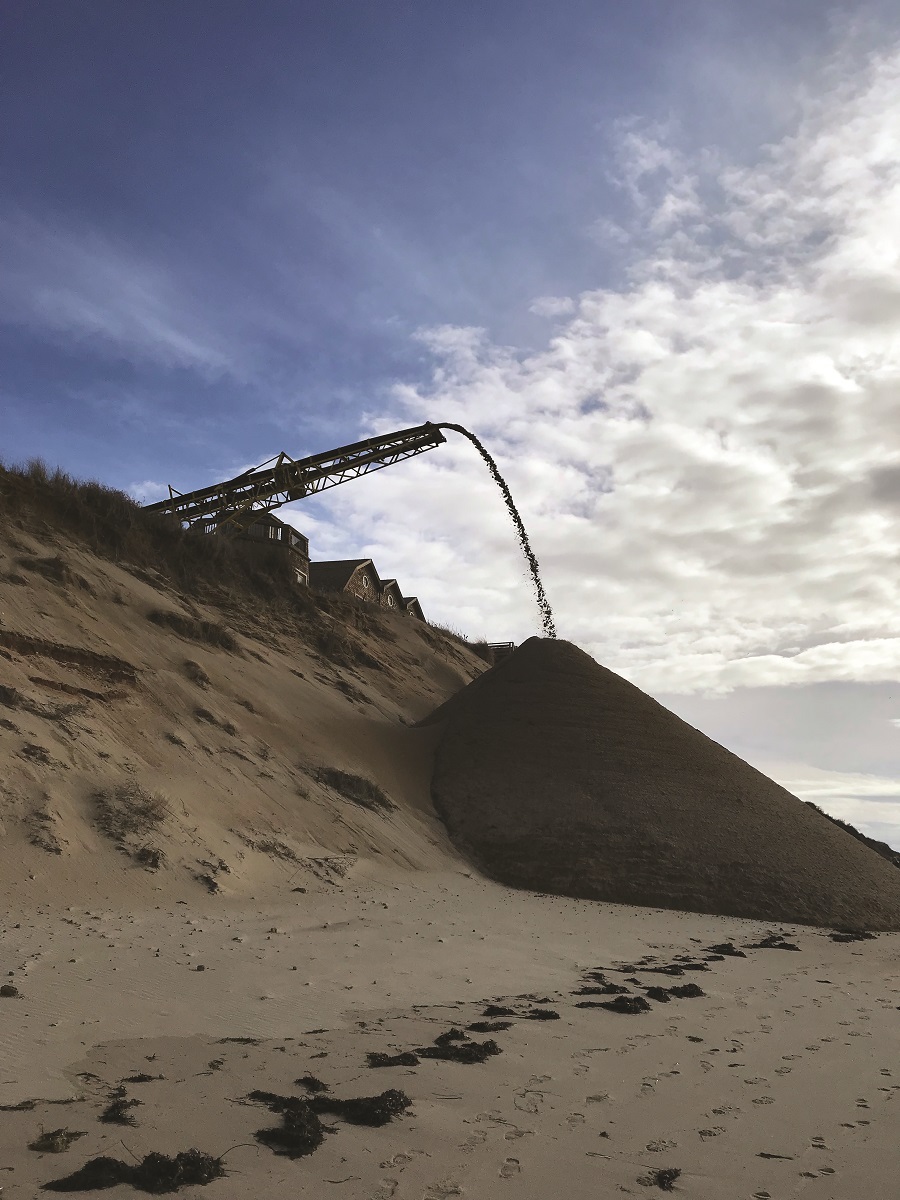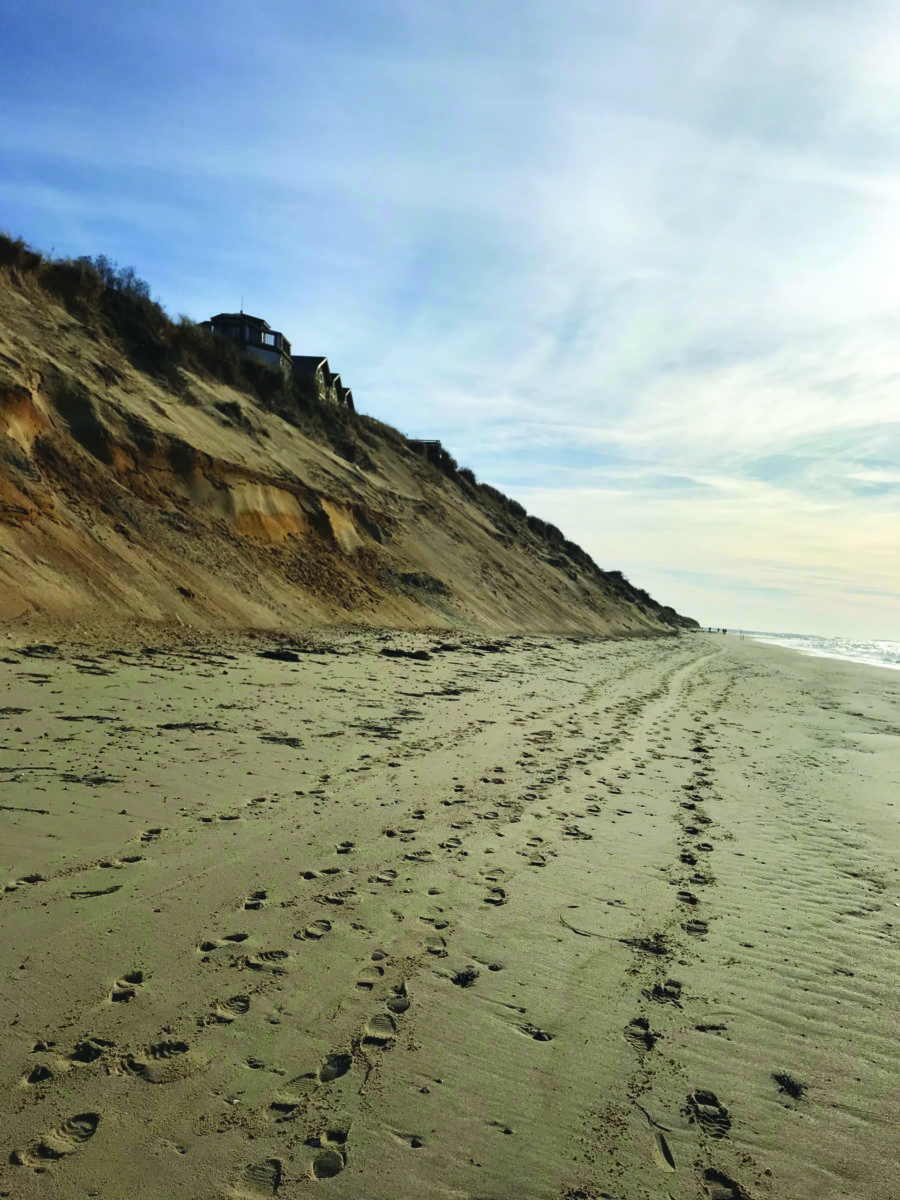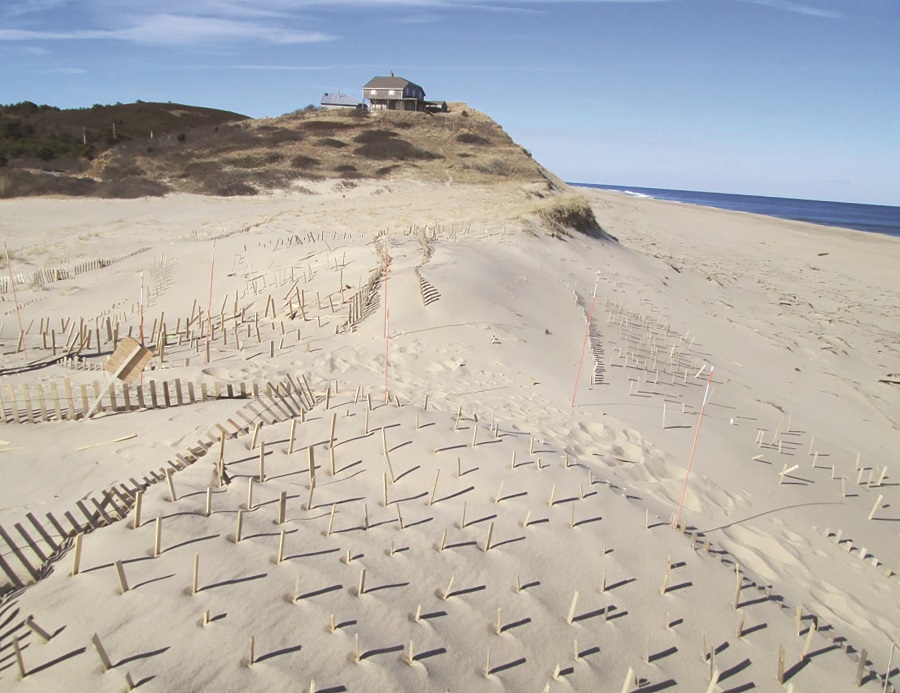WELLFLEET — The huge pile of sand dumped over the edge of the bayside bluff next to the Blasch house in November has entirely washed away, adding sediment to the water column that may harm fish and shellfish. That’s why experts working to preserve coastal land look to biomimicry and retreat instead.
As reported in the Independent on Nov. 14, 2019, the “sacrificial sand” was meant to act as a temporary buffer to keep the house from collapsing over the edge of the bluff. The thinking was that the sand would slow the rate of erosion by giving the waves something else besides the bluff to wash away.

But this year’s sand load, estimated at 2,000 cubic yards, did not stay in place for long. The “beach renourishment” lasted perhaps one month, according to observers.
Owners Barbara and Mark Blasch are suing the town over another protective strategy they want to try: building a 241-foot sea wall in front of their house.
Conservation Commissioner Barbara Brennessel walks the beach regularly and watched the pile of sand disappear.
“Anyone who’s walked that beach can see that,” Brennessel said.
Although she would not comment on the specifics of the Blasch property due to the lawsuit, Brennessel said that the benefits of beach renourishment are still open to debate. Often, wave and wind dynamics transport sand far from its starting point, she said.
“In the future,” Brennnessel said, “the sacrificial sand may be put not where the project is occurring but somewhere else that makes more sense.”
Cape Cod National Seashore maintenance chief Karst Hoogeboom agreed, adding sacrificial sand “doesn’t really slow the rate of erosion.”
Safe Harbor Environmental Services director Gordon Peabody remembers a six-foot dune, lined with vegetation, that once existed on the beach in front of the Blasch house. But stronger winds and bigger waves during winter storms have increased erosion rates. Now, that protective dune is gone. The bluff takes the force of breaking waves and is retreating at a rate of about three feet per year. The 5,595-square-foot house was only 25 feet from the edge a year ago.
“If you’re trying to do a dune restoration where there’s no dune, that’s not going to happen,” Peabody said.
The minutes of a Nov. 6 conservation commission meeting note the group’s concern about the environmental effects of sacrificial sand. Studies have shown that high amounts of suspended sediment in the water column can affect ocean organisms’ health by clogging their gills.
How to Restore a Dune
Both Hoogeboom and Peabody have led dune restoration efforts that reject renourishment and employ revegetation and biomimicry instead. These methods put nature to work to create more lasting solutions.

High winds carry more sand. Therefore, slowing the wind with vegetation is crucial to these methods.
At Ballston Beach in Truro, shortcuts through the dune vegetation led to massive erosion in the 1980s. As the vegetation was trampled, wind carried sand away and left the Pamet River’s headwaters unprotected.
Called in by the town after a 2009 storm led to an overwashed Pamet River, Peabody’s team placed slices of shingling around the dune to mimic dune grass and create turbulence. This slowed the wind, allowing sand to drop out — in some storms, large quantities were collected. Over 14 months the dune grew 12 feet higher in some areas.
Hoogeboom led a similar project to restore the dunes at Herring Cove in Provincetown. He said the final plantings of beach grass at the site were made just three weeks ago after a year and a half of work. Hoogeboom and his colleagues will now monitor the distance between the parking lot and beach to determine the rate of erosion.
At Herring Cove, “We anticipate the shoreline will stabilize with a more predictable rate of erosion than we’ve seen,” Hoogeboom said. The dunes are expected to mitigate storm damage by buffering waves before they can reach the parking lot.
Peabody said that about 400 feet of cross-section is enough for a coastal dune to weather storms. At that point, the dune itself changes the wind dynamics to collect its own sand without assistance.

But “when you’re down in Wellfleet on a coastal bank, that doesn’t work,” Peabody said.
Photographs taken this week show how grasses planted on the bluff just below the Blasch house, presumably as part of a restoration effort, have been undermined by the wind. (See photo on page 1.)
Even with these efforts, Hoogeboom, Peabody, and Brennessel agreed that the erosion cannot be stopped. Since the ice age, Cape Cod has been getting smaller, and human intervention can do little.
“What we’re talking about is how to mitigate some of the detrimental parts of erosion on the habitat and coastline in general,” Brennessel said.
Hoogeboom agreed. The Park Service prioritizes managed retreat: moving critical infrastructure inland. “We want to give natural forces a little space to act independently,” he said. “Not everybody has that option — people want to stabilize things in place. But long-term, it will keep eroding.”
